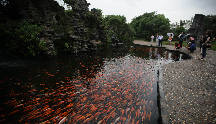Sentimental Journey: Recreation of a "Rust Belt"
Twist of Fate
Wujiaochang is now the destination in the northeastern part of Shanghai. It was once a tranquil intellectual pocket surrounded by villages and farmland. Some of China's top universities, such as Fudan, Tongji and Shanghai University of Finance and Economics, are located here, as well as a few military academies.
It was not until 1995, however, that its reputation expanded from the intellectual to the economic realm. In the year Chen Zhili, then deputy secretary of the CPC Shanghai Municipal Committee, asked: "The U.S. has a Silicon Valley, and Beijing has a Zhongguancun. As a convergence point of universities, shouldn't Yangpu District have its own high-tech park?" This led to the creation of the Wujiaochang High-tech Industrial Park. By 2008, it was home to more than 1,600 businesses and generated annual sales of RMB 7.2 billion.
Wujiaochang first gained its name during the Republican period. In 1927 the area stole the spotlight under the luster of the "Great Shanghai" program. Urban planners – assimilating the municipal construction experiments of Chicago, Washington and some other big cities of the world – drew out a blueprint for a new political center, a commercial and residential complex on the vast wasteland in the northeastern corner of the city. Implementation went as far as erection of a city hall, a library, a stadium, and five radiating roads connected with Wusong Harbor to the north, Qiujiang Wharf to the east, the railway terminal to the west, the International Settlement to the south, and the Bund to the southwest. Now these municipal legacies have become the elder statesmen of Shanghai infrastructure.
The commercial prestige of Wujiao-chang reached a peak in 2007, when a huge, polychromatic "egg," the illuminated steel box beam of a flyover bridge, was erected over the Wujiaochang traffic intersection island, marking the formation of a new shopping paradise. It is reported that now the business scale of Wujiaochang has surpassed that of Xujiahui, a legendary retailing area of Shanghai.
Yangpu also has ecological places to go. The Jiangwan Wetland is the only one of the kind in the city proper and its serene, pristine environment stands largely and miraculously intact within the busy and changing urbanity that nestles it. The Gongqing Forest Park also remains a popular get-away, especially for Shanghai picnickers. Yangpu District is now committed to a development plan that taps into the century-old intellectual and municipal legacies of Wujiaochang and an industrial civilization whose manifestations still line Yangshupu Road, as if in wait for their new place in the sun.
Services
Economy
- Eco-agriculture and Eco-tourism Power Nanchang’s Green Development
- Balance Environmental Protection and Economic Prosperity – Nanchang Looks to European Technology for Green Development
- Sustainable Growth Requires Wiser Energy Use
- Chinese Economy: On the Path of Scientific Development
- China's Economy over the Last Ten Years

